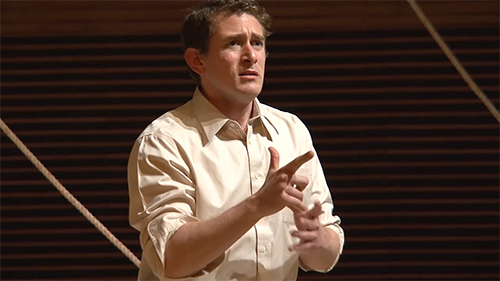 print preview
print previewback DAN O’BRIEN | Visitations
Video Director’s Notes
Mark DeChiazza
The large-scale video projections I designed for Theotokia and The War Reporter reached into and overlapped the theater’s architecture, breaking into the orderly arrangements of seats, aisles, and acoustic walls, and connecting them to the stage. I aimed to evoke a subjective space—the space constructed within a mind as it attempts to comprehend experience and create meaning. However, I needed a separate visual vocabulary for each opera to capture its essential themes in distinctive visual form.
In Theotokia, Leon’s schizophrenic and grandiose fantasy world needs imagery that expands and mystifies the perceived space of the theater. Incarcerated in an asylum, Leon’s experience of the world is sharply limited. But his delusion projects him to the center of a religious mystery—the ordinary morphs into the sacred and gains magical significance and meaning. I wanted to build looming miraculous fantasies by combining images of mundane things—paper, wax, charcoal scrawls, skin, flame, paint—in strange and sometimes disturbing ways. For example, Leon’s imagined cave in the Himalayas, home to the primitive goddess Yeti Mother, is evoked primarily by the gesture of an obsessively repeated circular charcoal stroke. The paper under the charcoal becomes the skin of a woman, which tears into the outline of a rudimentary bleeding cross, which at last bursts into flames. Later, drops of ink morph into rapidly dividing cells. During scenes in which Leon’s fantasy is disrupted or absent, such as the visit from his mother, the projections recede and disappear, emptying and diminishing the space while draining it of Leon’s delusional magic.
 |
| Screen capture from The War Reporter. Video directed by Eric Koziol. |
The War Reporter calls for a messier and more aggressive deployment of visual vocabulary to underscore the chaos and incomprehensibility of war, analogous to the conflict that rages inside Paul Watson, the opera’s protagonist. As a war photographer, he attempts to make sense of the senseless, and to frame an enormity that will always refuse to be neatly contained. Paul struggles and ultimately fails to exorcise the ghost of the dead soldier who haunts him. Ultimately he realizes that he has to accept his experience without interpreting it and move on. I contacted the real Paul Watson and convinced him to provide me with his reject images—unpublished photos that he was willing to let me hack up and recompose. He generously furnished me with many. I found it impossible to use any imagery drawn from the photos’ actual subjects as scenery; what occupied the center of these photos was graphic, personal, and sometimes horrific, and would have presented as exploitative, distracting, and tasteless if displayed as background in a work of theater. But it was the chaos in the periphery—meant to be discarded and left behind—that drew my attention and became my raw material. I was interested in the “non-subject” of these photographs. From peripheral elements, I could assemble a clashing world of violence and light that never quite coalesced into any clear picture: layers of broken stone and bombed-out buildings rearranged to compose a confusion of space, or gusts of desert sand blowing across and erasing the steps of Columbia University’s library. This is a visual chaos that invades, tumbles in and takes over, obscuring clarity, composition, and focus. ![]()
![]()
Mark DeChiazza is a director, filmmaker, designer, and choreographer whose projects often involve contemporary classical music. His work has been presented by prominent national venues including Lincoln Center, Carnegie Hall, Prototype Festival, Stanford Live, the Kennedy Center in Washington, D.C., and Museum of Contemporary Art, Chicago.